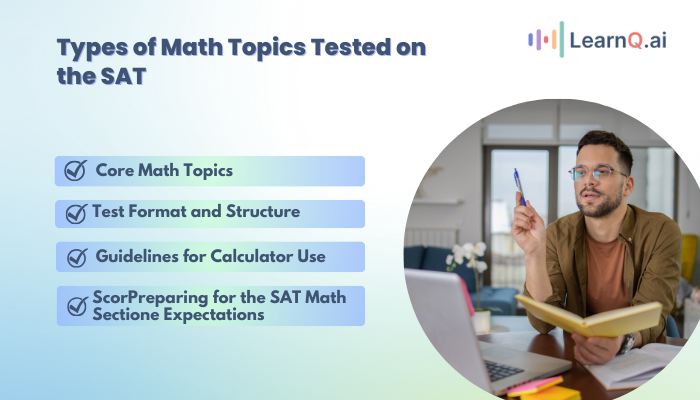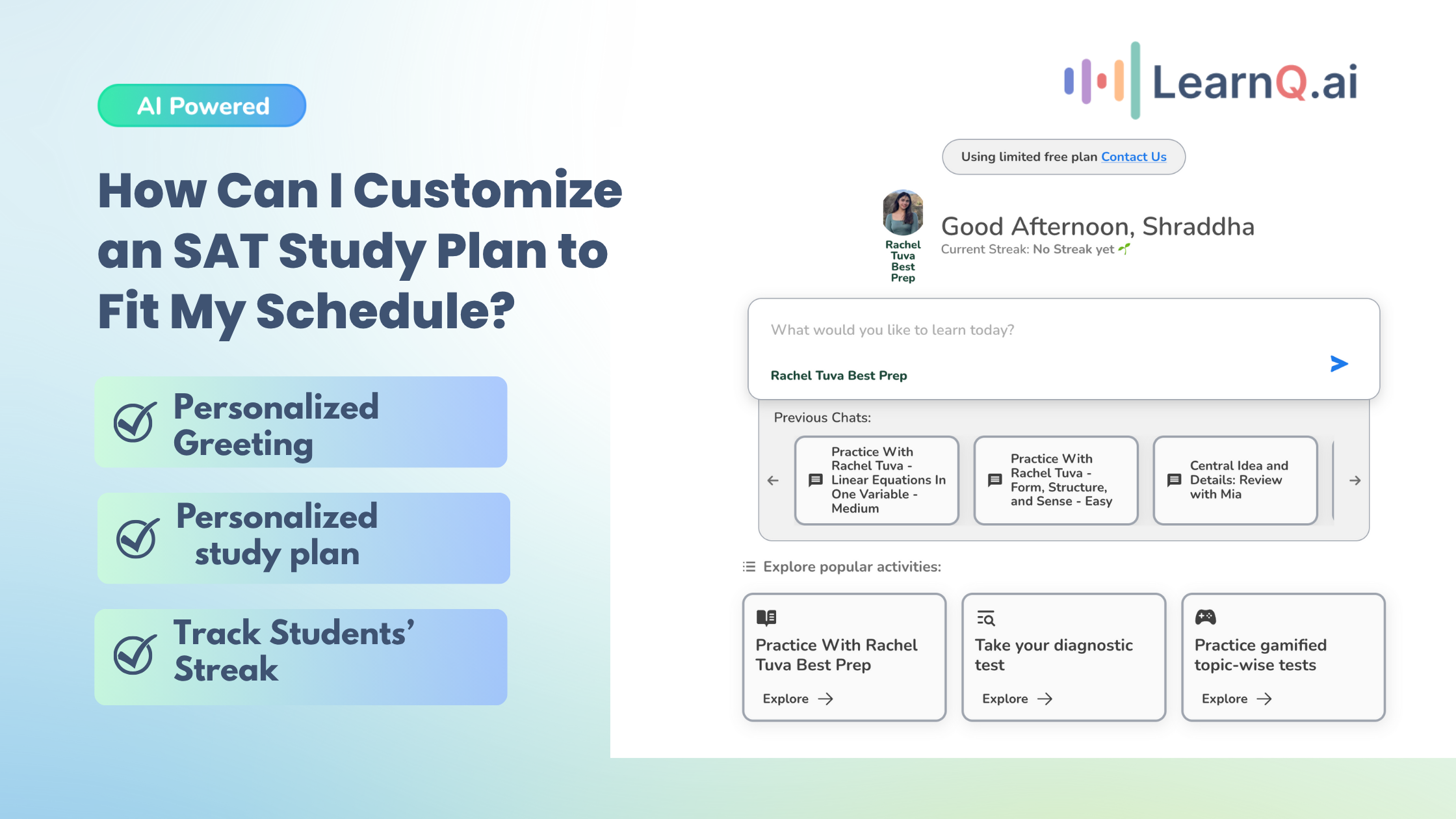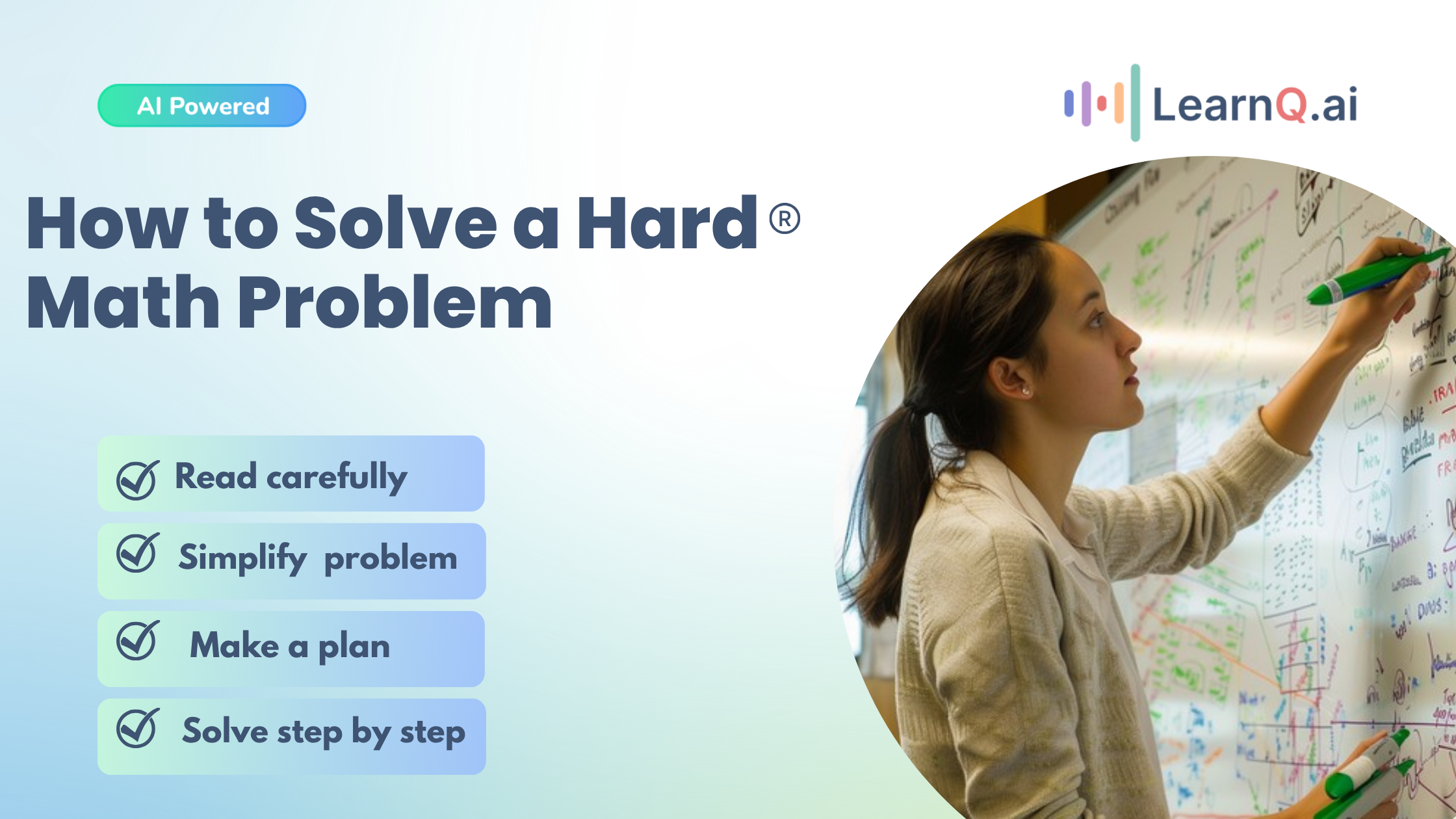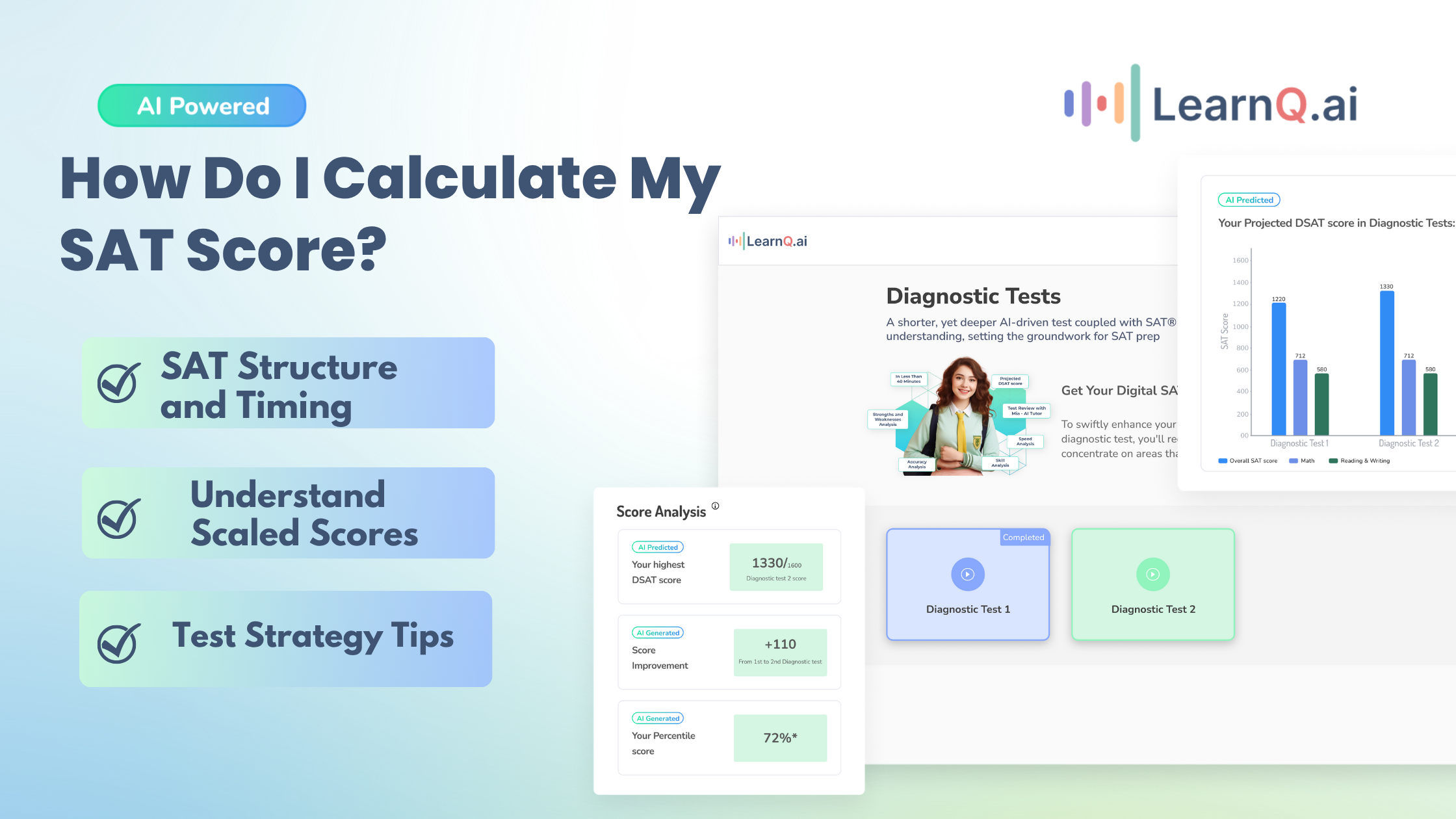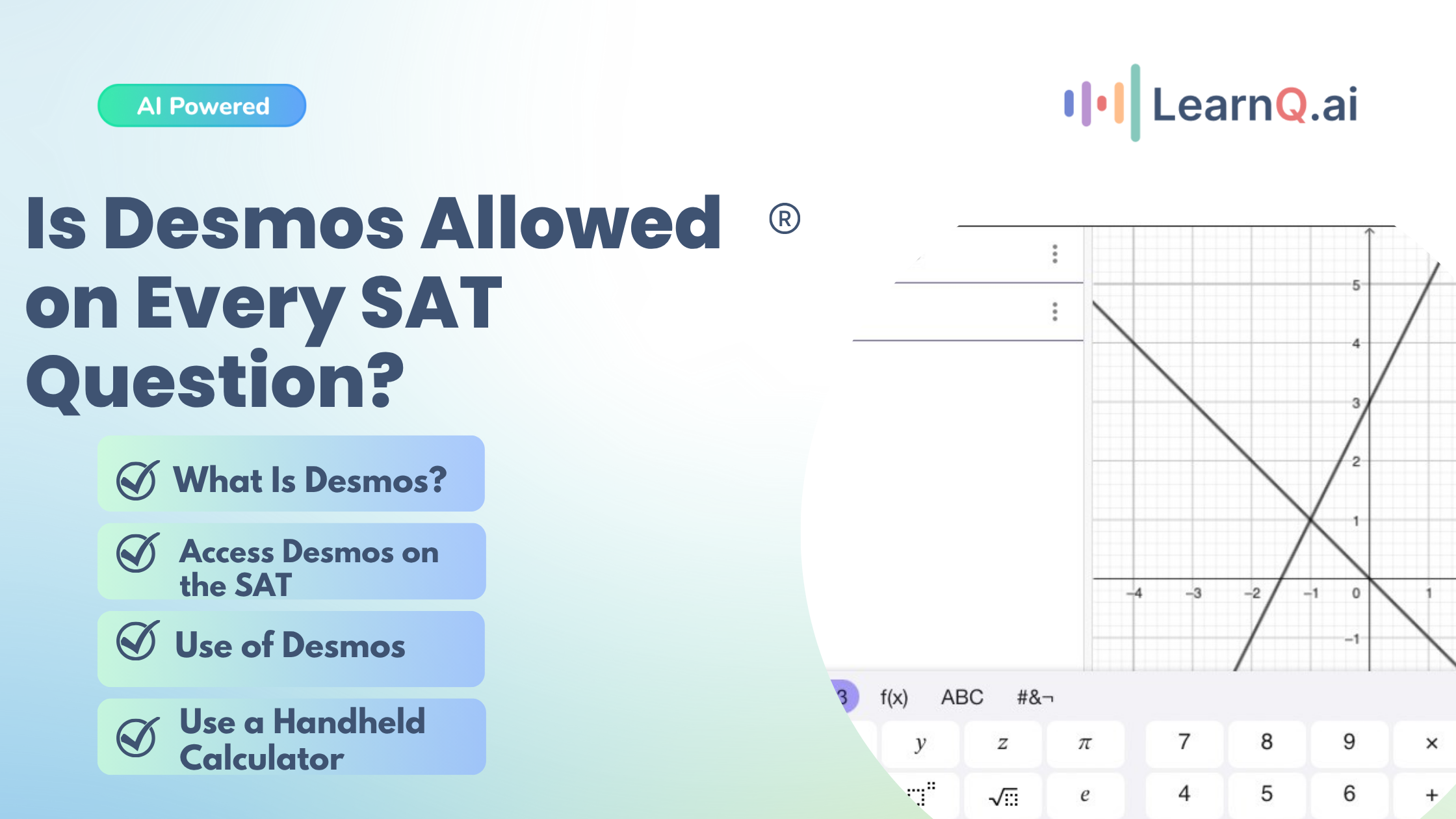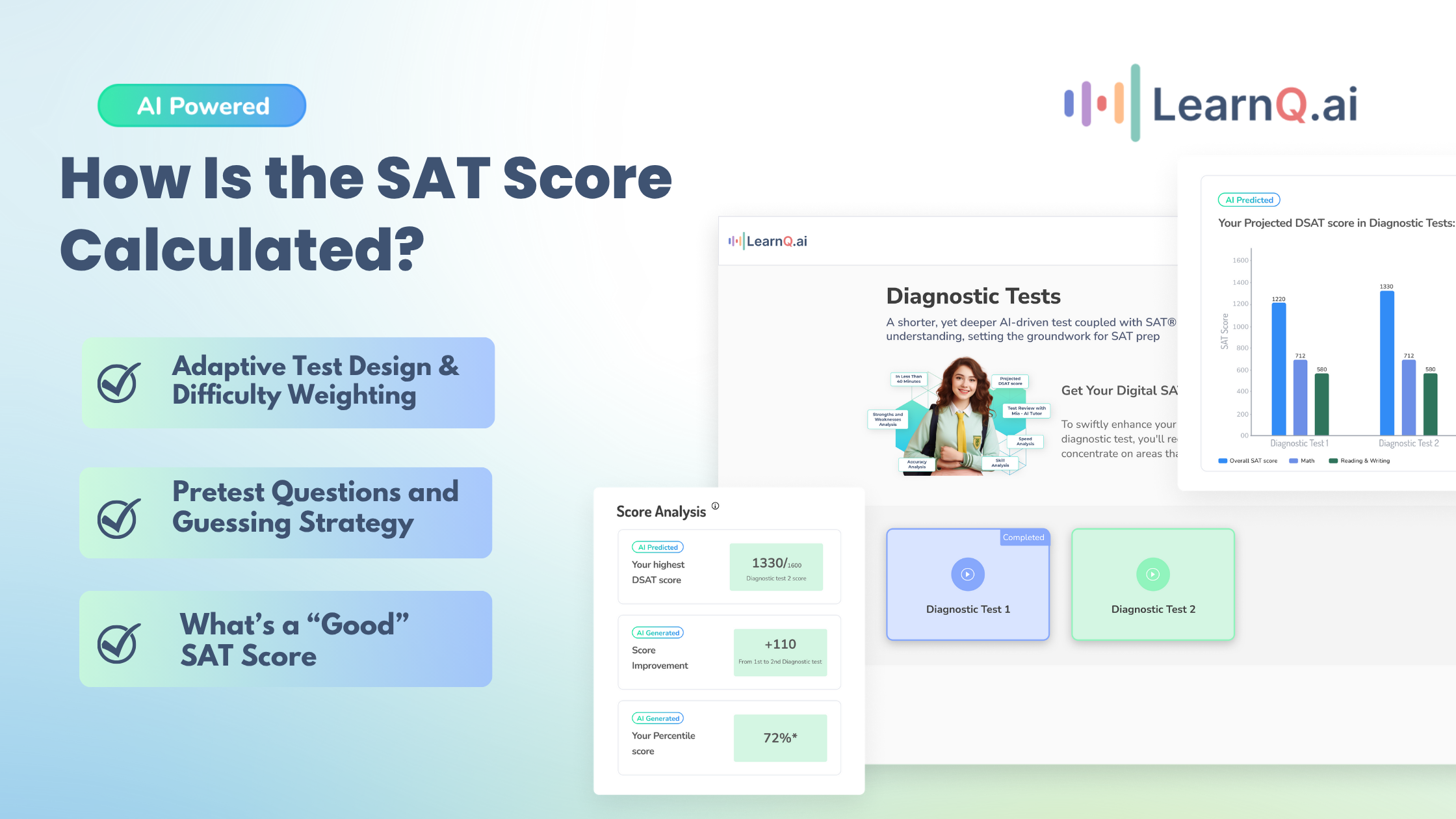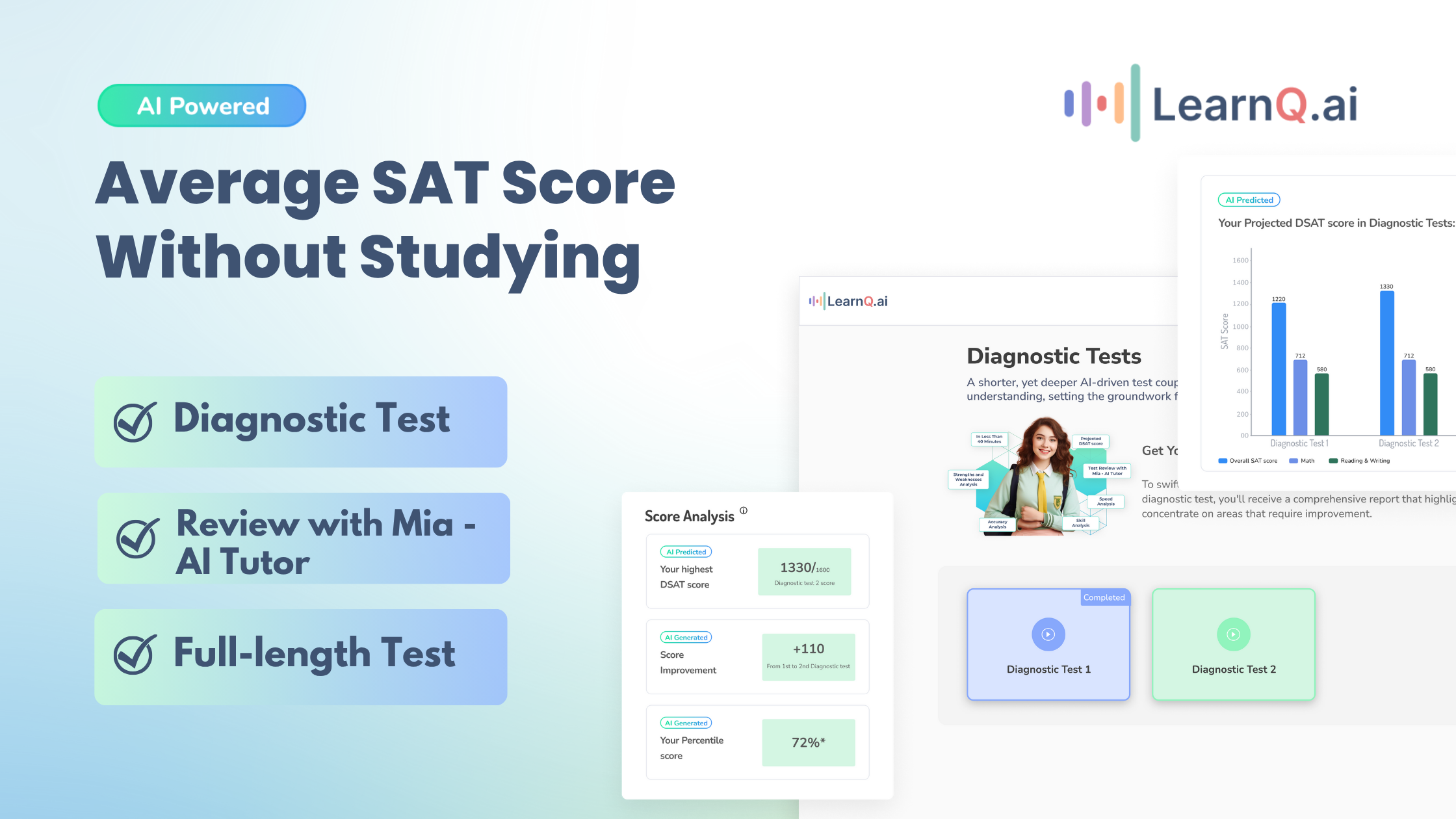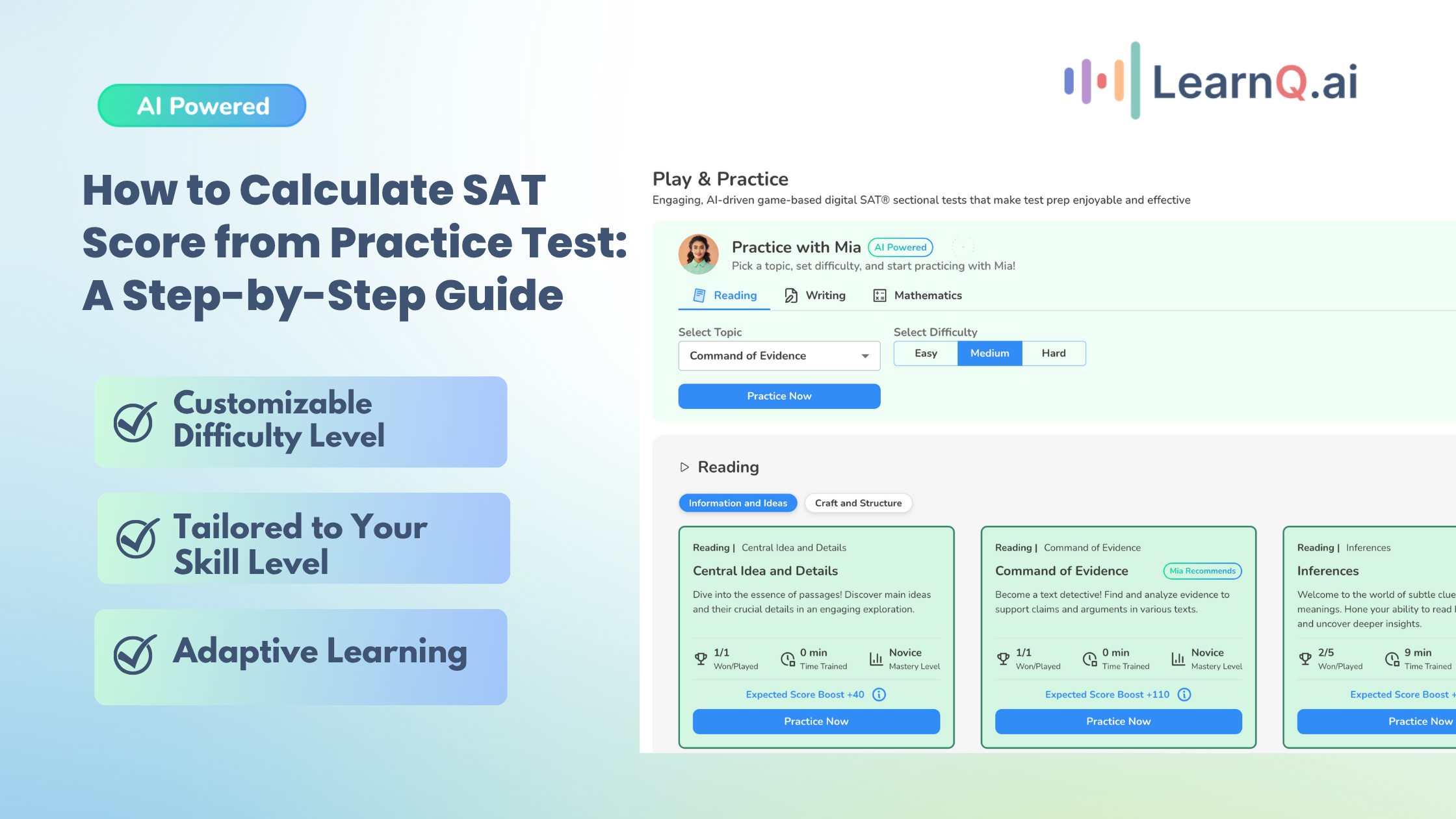The SAT Math section plays a major role in college admissions, testing both your mathematical knowledge and your critical thinking skills. Mastering these math topics—from algebra and geometry to data analysis and trigonometry—can make a significant difference in your overall score.
Each math concept on the SAT serves a purpose, assessing not only your computational ability but also how well you can apply concepts under time pressure.
A strong SAT Math score reflects readiness for college-level work. Success here shows colleges you have the skills to handle rigorous courses and solve complex problems. By focusing on core areas, practicing targeted questions, and honing your timing, you can boost your score and confidence.
With tools like LearnQ.ai, you can optimize your preparation by focusing on weaker areas, tracking progress, and receiving personalized feedback. This approach helps you practice smarter, master concepts faster, and ultimately improve your SAT performance.
LearnQ.ai is Powered by VEGA AI—Is your Institute Next?
Give students a Duolingo-style test-prep platform with Shopify-level customization for tutors and institutes.
Core Math Topics on the SAT and How LearnQ.ai Enhances Your Preparation
Preparing for the SAT Math section means mastering a range of essential topics, each testing a different set of skills. Here’s a look at the core areas and how LearnQ.ai supports your learning journey with targeted practice, step-by-step explanations, and personalized feedback for continuous improvement.
1. Algebra
The SAT Math section emphasizes concepts like linear equations, inequalities, and functions. You’ll work with single-variable equations, manipulate algebraic expressions, and interpret basic functions.
- Example: Solve for x in the equation 5x – 15 = 25.
- To isolate x, add 15 to both sides, resulting in 5x = 40. Then divide by 5 to find x = 8.
- How LearnQ.ai Helps: LearnQ.ai offers targeted algebra practice that adapts to your performance, focusing on areas like linear functions and inequalities. By offering hints and detailed explanations, it helps build foundational algebra skills. Personalized feedback allows you to master these topics through repetitive practice on similar problems until you’re confident.
2. Problem Solving and Data Analysis
This section tests your ability to apply math to real-world scenarios. You’ll work with ratios, percentages, proportional relationships, and data interpretation. Many questions appear as word problems, requiring you to translate descriptions into mathematical equations.
- Example: If 30% of a class of 50 students prefers a particular book, how many students is that?
- You calculate 0.3 × 50 = 15, meaning 15 students.
- How LearnQ.ai Helps: LearnQ.ai provides scenario-based questions that simulate real-world data analysis, including interpreting tables, graphs, and percentages. Interactive data visualization tools help you read and interpret different types of data, improving your ability to recognize patterns and process complex information efficiently.
3. Advanced Math
Advanced Math problems include nonlinear functions, complex quadratic equations, and exponential relationships. This section requires familiarity with polynomials, rational functions, and quadratic expressions.
- Example: Solve the quadratic equation x² – 9 = 0.
- To find the solution, add 9 to both sides, yielding x² = 9. Then, take the square root of both sides: x = ±3.
- How LearnQ.ai Helps: LearnQ.ai’s advanced math modules cover challenging topics like quadratics and exponentials. The platform’s AI-driven design identifies your specific areas of difficulty, providing additional practice problems to ensure solid understanding. This reinforcement helps you build confidence in tackling non-linear equations.
4. Geometry
Geometry questions on the SAT include properties of shapes, area, perimeter, volume, and coordinate geometry. These questions test your ability to calculate angles, interpret spatial relationships, and apply geometric principles to real-world shapes.
- Example: Find the area of a circle with radius 4.
- The formula for the area is A = π × r², so A = π × 4² = 16π.
- How LearnQ.ai Helps: LearnQ.ai’s visual aids and interactive tools make it easier to explore geometric principles. Dynamic graphing exercises and step-by-step solutions clarify challenging problems, such as working with circles, triangles, and other polygons, so complex geometry becomes manageable.
5. Trigonometry
Basic trigonometry on the SAT primarily involves right triangle properties and trigonometric ratios (sine, cosine, tangent). These questions require understanding trigonometric functions to find missing sides or angles in triangles.
- Example: In a right triangle where the opposite side is 6 and the hypotenuse is 10, find sin(θ).
- Here, sin(θ) = 6/10 = 0.6.
- How LearnQ.ai Helps: LearnQ.ai provides guided exercises for trigonometric concepts, breaking down sine, cosine, and tangent applications. Visual guides simplify right triangle problems and apply trigonometric ratios effectively, ensuring you’re ready for any trig-based questions.
6. Statistics and Probability
This section covers measures like mean, median, mode, and basic probability. You’ll interpret data sets, calculate probabilities for events, and work with basic statistical measures.
- Example: Find the median of the set {3, 7, 9, 11, 12}.
- The median, or middle value, is 9.
- How LearnQ.ai Helps: LearnQ.ai offers practice scenarios for calculating averages, interpreting data distributions, and applying probability. Detailed solutions show you how to identify relevant statistics and interpret results quickly. Progress tracking lets you monitor each topic thoroughly, allowing you to focus on weak areas in data and probability.
LearnQ.ai transforms SAT prep into a personalized learning experience. With adaptive, AI-driven practice, step-by-step explanations, and progress tracking, it allows you to focus on building confidence and mastering each SAT Math concept effectively.
Also Read: Tips for Solving Problems on SAT Practice Test With Study Plan
Test Format and Structure of the SAT Math Section
The SAT Math section is divided into two types of questions—multiple-choice and grid-in (student-produced response) questions—and also has specific rules for calculator usage. Understanding each format will help you develop a strong test-taking strategy, ensuring accuracy and efficiency on test day.
Question Types: Multiple-Choice and Grid-In Questions
The SAT Math section includes two distinct types of questions, each designed to test different skills and approaches.
- Multiple-Choice Questions
These questions make up most of the SAT Math section and require you to choose the correct answer from four options. They assess a variety of math concepts, including algebra, geometry, data analysis, and trigonometry. Multiple-choice questions often include distractors—answers that seem plausible but are incorrect—to test your understanding and accuracy.- Example Multiple-Choice Problem:
A rectangle has a length of 10 and a width of 5. What is the perimeter of the rectangle?- Options:
- (A) 20
- (B) 25
- (C) 30
- (D) 40
- Solution:
The formula for the perimeter of a rectangle is 2×(length+width)2 \times (length + width)2×(length+width). So, 2×(10+5)=302 \times (10 + 5) = 302×(10+5)=30. - Answer: (C) 30
- Options:
- Example Multiple-Choice Problem:
- Strategy: For multiple-choice questions, use the process of elimination. Even if you’re unsure of the formula, you can often eliminate answers that are too high or low. This approach can help you narrow down options and make an educated guess.
- Grid-In Questions (Student-Produced Responses)
Grid-in questions require you to solve a problem and enter the answer directly into a grid. These questions eliminate the option to guess from multiple choices, so accuracy and problem-solving skills are essential. Grid-in responses accept positive integers, decimals, and fractions, but answers should be formatted carefully to avoid losing points due to mis-entering values.- Example Grid-In Problem:
If x+5=12x + 5 = 12x+5=12, what is the value of xxx?- Solution:
Solving for xxx gives x=12−5=7x = 12 – 5 = 7x=12−5=7. - Answer to Grid-In: 7
- Solution:
- Another Grid-In Example:
A recipe requires 34\frac{3}{4}43 cup of sugar. If you want to make a batch that is 1.5 times the original recipe, how much sugar will you need?- Solution:
34×1.5=98\frac{3}{4} \times 1.5 = \frac{9}{8}43×1.5=89 or 1.125 cups. - Answer to Grid-In: Either “1.125” or “9/8” (both would be correct if properly gridded).
- Solution:
- Example Grid-In Problem:
- Strategy: Practice the grid-in format before the test. For example, always ensure decimals are written correctly within the allowed grid space. If a fraction is easier to write than a decimal (or vice versa), choose the format that’s quicker for you.
Also Read: The Benefits of Taking a Full-Length Digital SAT Mock Test
Calculator Policy: Guidelines for Calculator Use on the SAT
The SAT Math section is divided into two parts: one that allows calculator use and one that does not. Understanding the SAT’s calculator policy is essential for success.
- Calculator-Allowed Section
In the calculator section, you can use a calculator on 38 questions. This section includes complex calculations that may involve multiple steps or larger numbers. However, knowing when not to use your calculator is equally important, as some questions can be solved faster mentally or by simplifying the steps. Over-relying on the calculator can eat up valuable time, so use it strategically for complex arithmetic, graphing functions, and multi-step problems.- Example Calculator Problem: If a car travels 240 miles in 4 hours, what is its average speed?
- Solution: Divide 240 by 4 using the calculator to find the speed, which is 60 miles per hour.
- Example Calculator Problem: If a car travels 240 miles in 4 hours, what is its average speed?
- Tip: Familiarize yourself with common calculator functions you’ll use on the test, such as square roots, exponents, and graphing capabilities if using a graphing calculator. This will help save time.
- No-Calculator Section
The no-calculator section includes 20 questions that test your arithmetic and algebra skills. These questions emphasize your foundational math skills, especially in basic operations, simplifying expressions, and solving equations by hand. Being able to perform these calculations mentally or on scratch paper without a calculator is crucial.- Example No-Calculator Problem: If 2x+5=152x + 5 = 152x+5=15, solve for xxx.
- Solution: Subtract 5 from both sides, giving 2x=102x = 102x=10. Divide by 2 to find x=5x = 5x=5.
- Example No-Calculator Problem: If 2x+5=152x + 5 = 152x+5=15, solve for xxx.
- Tip: Practice these foundational skills without a calculator to build confidence in performing basic calculations accurately and quickly.
Enhance your Digital SAT study routine with AI-driven insights and personalized practice tests.
Preparing for the SAT Math Section with This Structure in Mind
- Multiple-Choice Questions: Use strategies like eliminating incorrect answers and plugging in values to solve efficiently. Aim to identify common errors and practice answering similar questions to avoid “trap” answers.
- Grid-In Questions: For grid-in responses, practice writing answers neatly in the grid format and using decimals or fractions appropriately. This section rewards precision, so it’s vital to work carefully.
- Calculator Use: Use the calculator selectively in the calculator-allowed section. Know which types of calculations are faster without it, and get comfortable with your calculator functions.
Understanding the SAT Math section’s structure, question types, and calculator policy will make you a more strategic and confident test-taker. Consistent practice, attention to question format, and familiarity with calculator usage are key to navigating the SAT Math section successfully.
Also Read: Digital SAT Practice Questions & Resources
How LearnQ.ai Can Help You Prepare for the SAT Math Section
Preparing for the SAT Math section takes more than just understanding formulas and concepts; it requires a structured approach, targeted practice, and insights into personal progress. LearnQ.ai offers a comprehensive and adaptive platform designed to maximize your preparation through personalized practice, detailed feedback, and interactive learning tools. Here’s how LearnQ.ai can elevate your SAT Math prep:
1. Personalized Practice Questions
LearnQ.ai provides practice questions that adapt to your skill level and focus on areas that need improvement. As you work through problems, the platform identifies topics where you’re struggling and offers additional practice until you master each concept. This adaptive approach saves time by focusing only on relevant areas.
- Example: If you’re consistently missing questions involving quadratic equations, LearnQ.ai will assign similar questions, walking you through step-by-step solutions and explanations to reinforce your understanding of quadratic functions and factoring.
2. Interactive Concept Videos
LearnQ.ai includes interactive concept videos for tough math topics, such as geometry, trigonometry, and data analysis. These videos offer detailed explanations, breaking down each step of complex problems and helping you visualize key concepts. This visual approach is especially useful for students who find certain topics, like graphing or geometry, challenging to grasp from text alone.
- Example: For challenging geometry problems, LearnQ.ai’s videos might illustrate each part of a complex shape or equation, highlighting properties and guiding you through the process of calculating area, perimeter, or volume.
Enhance your Digital SAT study routine with AI-driven insights and personalized practice tests.
3. Grid-In Practice and Multiple-Choice Strategies
LearnQ.ai prepares you for both multiple-choice and grid-in questions with customized strategies and practice exercises that emphasize accuracy and efficiency. Since grid-in questions require precise answers without multiple-choice options, LearnQ.ai’s tools help you practice converting fractions and decimals to grid formats and encourage double-checking to avoid simple mistakes.
- Example: The platform provides a tutorial on grid-in formatting, showing how to enter answers like fractions or repeating decimals correctly, which ensures you’re comfortable with the exact format required on the SAT.
4. Progress Tracking and Analytics
One of the biggest challenges in SAT prep is tracking improvement. LearnQ.ai includes progress tracking and analytics that provide insights into your strengths and weaknesses. This data-driven approach helps you focus on areas that require additional review and celebrate the progress in topics you’ve mastered.
- Example: If your analytics reveal that you’ve improved significantly in data analysis but still need work in trigonometry, you can adjust your study plan. LearnQ.ai’s dashboard visualizes your learning progress, making it easy to prioritize certain topics based on past performance.
LearnQ.ai is powered by VEGA AI—Is your institute next?
Offer students a Duolingo-style test-prep platform with Shopify-level customization for tutors and institutes.






Conclusion
The SAT Math section challenges students on core topics like algebra, geometry, data analysis, and advanced math functions, testing their critical thinking and problem-solving skills. For students, mastering these concepts is essential to achieve a competitive score and demonstrate readiness for college-level work.
For students and independent learners, LearnQ.ai offers an adaptive, personalized prep solution. Its interactive videos, targeted practice questions, and progress-tracking tools ensure students focus on their specific weak areas, building confidence and proficiency. This comprehensive approach helps maximize students’ potential, setting them up for success on test day.
For partners—including schools, tutoring centers, and test prep companies—LearnQ.ai provides a scalable platform that enhances math preparation for large student groups.
With customizable progress analytics and a wide range of adaptive tools, LearnQ.ai integrates easily into existing curriculums. This not only saves instructors’ time but also allows them to monitor and guide each student’s progress effectively.
To take your SAT Math preparation, or that of your students, to the next level, explore LearnQ.ai today. Its extensive math resources, strategic tools, and adaptive learning environment offer everything you need for effective and results-driven SAT preparation.

